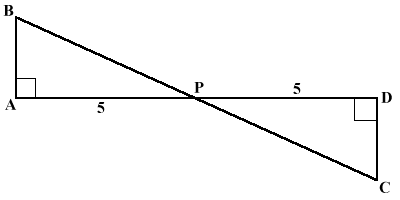Geometry/Chapter 5
Section 5.1 - Methods of Proving that Triangles are Congruent
[edit | edit source]SSS Congruency
[edit | edit source]Side-Side-Side Congruency Theorem: If three sides of one triangle equal the corresponding parts of the other, then the triangles are congruent.
SAS Congruency
[edit | edit source]Side-Angle-Side Congruency Theorem: If two sides and the included angle of one triangle equal the corresponding parts of the other, then the triangles are congruent.
We can prove ΔRPQ is congruent to ΔVST because both angle RQP and angle VTS are 100°. Segments PQ and ST are both 4 units, as well as RQ and VT are both 5 units. Therefore, both triangles are congruent by side-angle-side congruency.
HL Congruency
[edit | edit source]Hypotenuse Leg Congruency Theorem: If a right triangle has a leg and hypotenuse equal to the corresponding parts of the other triangle, then the triangles are congruent.
 A squared plus B squared equals C squared
A squared plus B squared equals C squared
ASA Congruency
[edit | edit source]Angle-Side-Angle Congruency Theorem: If two angles and the included side of one triangle equal the corresponding parts of the other, then the triangles are congruent.
Angle BAP is a right angle and angle PDC is also a right angle.So they are equal. Angle APB of triangle BAP and angle CPD of triangle DPC are opposite angles and they are equal. Segments AP and PD are both 5 units.Since , the two angles and a side of the triangle BAP is equal to the two angles and a side of the triangle DPC , the both triangles are congruent.
AAS Congruency
[edit | edit source]Angle-Angle-Side Congruency Theorem: If one side and two angles of one triangle equal the corresponding parts of the other, then the triangles are congruent.
We can prove ΔABC is congruent to ΔYXZ because angle CAB and angle ZYX are congruent (both 75°), angles ACB and YZX are congruent (both 65°), and AB is congruent to YX (nonincluded side). Therefore, both triangles are congruent by angle-angle-side.
AAA doesn't work
[edit | edit source]Three corresponding angles of a triangle doesn't prove two triangles are congruent. However, they do prove that two triangles are similar.
[[:Image:]]
SSA doesn't work
[edit | edit source]Two consecutive sides and an angle doesn't prove triangles are congruent.
[[:Image:]]
Basic Principles of Congruent Triangles
[edit | edit source]Conjecture 1: If two triangles are congruent, then their corresponding parts are equal.
Chapter Review
[edit | edit source]In order to prove that two triangles are congruent, three pieces of information are necessary. The three pieces of information can be
- the lengths of all three sides
- the lengths of 2 sides and the size of the included angle
- 2 angle measurements and the length of the enclosed side
- 2 angle measurements and the length of the following side
For right triangles, only two pieces of information are necessary. If you can show that the hypotenuse and another side are congruent on each triangle, then you know that the triangles on the whole are congruent.
It is worth noting that you cannot prove that two triangles are congruent if you only know their angle measurements. Even if you know every angle in each triangle, the lengths of the sides could be different.
Vocabulary
[edit | edit source]- Side-Side-Side Congruency Theorem: If three sides of one triangle equal the corresponding parts of the other, then the triangles are congruent.
- Side-Angle-Side Congruency Theorem: If two sides and the included angle of one triangle equal the corresponding parts of the other, then the triangles are congruent
- Angle-Side-Angle Congruency Theorem: If two angles and the included side of one triangle equal the corresponding parts of the other, then the triangles are congruent.
- Angle-Angle-Side Congruency Theorem: If one side and two angles of one triangle equal the corresponding parts of the other, then the triangles are congruent.
- Hypotenuse Leg Congruency Theorem: If a right triangle has a leg and hypotenuse equal to the corresponding parts of the other triangle, then the triangles are congruent.
Exercises
[edit | edit source]Answers to each exercise can be found in the Appendix.
- In triangle RUN and triangle HID, angle R = angle D, angle U = angle I, and RU = DI. What triangles are congruent, if any, and why?
- In triangle FRE and SLV, FR = LV, EF = SL, and angle F = angle S. What triangles are congruent, if any, and why?
- In triangle MUS and CHR, angle S = angle H, US = HR, and angle U = angle R. What triangles are congruent, if any, and why?
- In triangle QWE and RTY, QW = TY, WE = RY, and QE = RT. What triangles are congruent, if any, and why?
Navigation
- Geometry Main Page
- Motivation
- Introduction
- Geometry/Chapter 1 - HS Definitions and Reasoning (Introduction)
- Geometry/Chapter 1/Lesson 1 Introduction
- Geometry/Chapter 1/Lesson 2 Reasoning
- Geometry/Chapter 1/Lesson 3 Undefined Terms
- Geometry/Chapter 1/Lesson 4 Axioms/Postulates
- Geometry/Chapter 1/Lesson 5 Theorems
- Geometry/Chapter 1/Vocabulary Vocabulary
- Geometry/Chapter 2 Proofs
- Geometry/Chapter 3 Logical Arguments
- Geometry/Chapter 4 Congruence and Similarity
- Geometry/Chapter 5 Triangle: Congruence and Similiarity
- Geometry/Chapter 6 Triangle: Inequality Theorem
- Geometry/Chapter 7 Parallel Lines, Quadrilaterals, and Circles
- Geometry/Chapter 8 Perimeters, Areas, Volumes
- Geometry/Chapter 9 Prisms, Pyramids, Spheres
- Geometry/Chapter 10 Polygons
- Geometry/Chapter 11
- Geometry/Chapter 12 Angles: Interior and Exterior
- Geometry/Chapter 13 Angles: Complementary, Supplementary, Vertical
- Geometry/Chapter 14 Pythagorean Theorem: Proof
- Geometry/Chapter 15 Pythagorean Theorem: Distance and Triangles
- Geometry/Chapter 16 Constructions
- Geometry/Chapter 17 Coordinate Geometry
- Geometry/Chapter 18 Trigonometry
- Geometry/Chapter 19 Trigonometry: Solving Triangles
- Geometry/Chapter 20 Special Right Triangles
- Geometry/Chapter 21 Chords, Secants, Tangents, Inscribed Angles, Circumscribed Angles
- Geometry/Chapter 22 Rigid Motion
- Geometry/Appendix A Formulae
- Geometry/Appendix B Answers to problems
- Appendix C. Geometry/Postulates & Definitions
- Appendix D. Geometry/The SMSG Postulates for Euclidean Geometry




